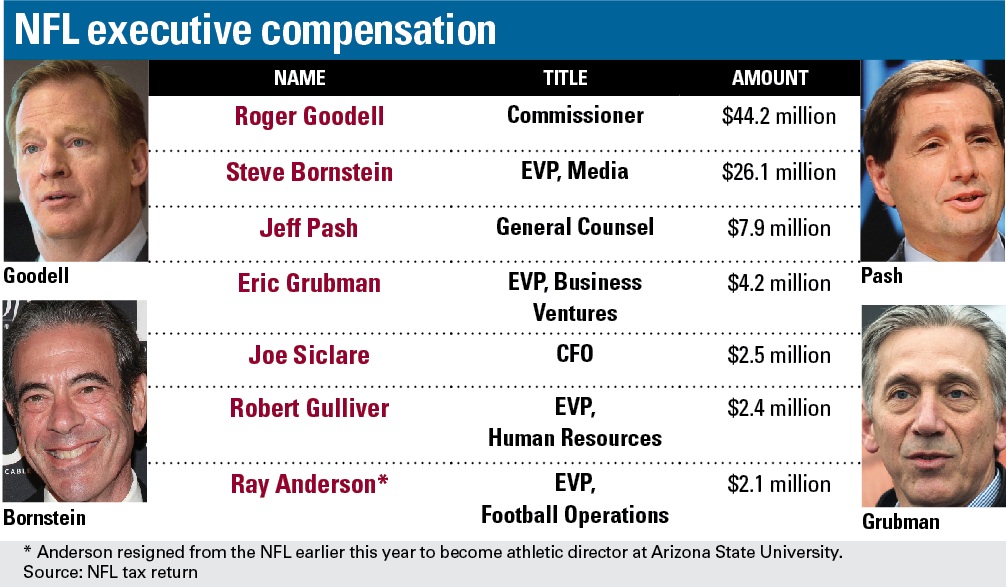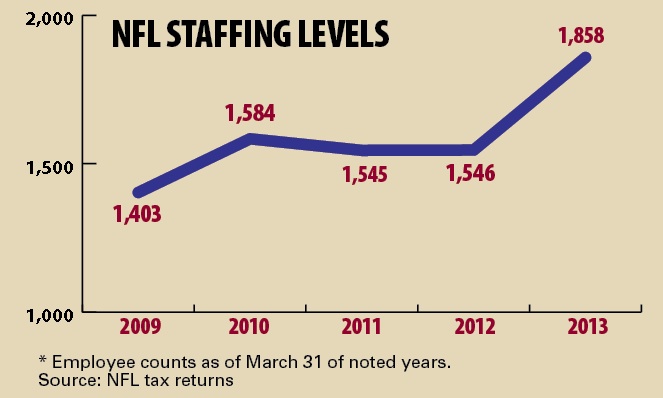The NFL aggressively added to its staff in the 12-month period ended March 31, 2013, with the league’s employment level jumping by 20 percent, to 1,858 employees, according to a review of the NFL’s two most recent tax returns.
That employment figure includes staff for the league office, some game-day operations, NFL Films and NFL Network, but not staffing at the league’s 32 teams. The clubs do, however, have a tie to the additional 312 employees that were hired in that the teams were called upon in part to help pay for the new head count. Teams paid $10.2 million each to fund the league in the 12-month period ending in 2013, a sharp 28 percent jump from the year-earlier period and the highest level for teams to date.
The NFL filed its most recent tax return with the IRS last week.
“[The NFL] added more sideline personnel on game day to run the injury surveillance systems, add[ed] more people to work at league meetings, added more people for production of Thursday night games,” NFL spokesman Brian McCarthy wrote in an email explaining the employee number. “Most of the people work just on game day or a short assignment.”
The Thursday night games have been on NFL Network but now will be split between NFL Network and CBS Sports for the coming season. Notably, though, CBS will assume the production costs for the full slate.
McCarthy also cited the staffing needs of the four-hour morning show on NFL Network, “NFL AM,” for causing the staffing jump. The show debuted in summer 2012.
The overall cost of running the league has risen sharply for the teams in recent years, with a near doubling over the five years ended March 31, 2013, according to an analysis of the NFL’s tax returns. The 32 clubs paid $327 million in the 12 months ended March 31, 2013. Five years prior, for the year ended March 31, 2008, the sum was about $166 million, or $5.2 million per club.
“As a general principle, it is still an efficient use of money because about 75 to 80 percent of team revenues are generated at the league level,” said Marc Ganis, a sports consultant with strong ties to the NFL. Also, he said, the rise in overall revenue is generally proportional to the percentage rise in club dues. The league’s annual revenue has increased from $6.5 billion five years ago to $10 billion now.
What else is the owners’ money paying for?
The biggest expense item for the NFL is interest cost from leaguewide financings, like the stadium financing bonds that reside on the league’s balance sheet. The NFL’s total cost in the year ended March 31, 2013, was $123 million, an amount that’s down from $135 million the year earlier.
The second-biggest cost — but arguably the most discussed publicly — is compensation. That sum was $102.3 million in the 12 months ended March 31, 2013, and that total included the $44.2 million paid to Commissioner Roger Goodell.
Not only did Goodell’s compensation increase over the past year, but the amount that his pay represents of full league pay increased as well. In the year ended March 31, 2012, Goodell’s $29.5 million compensation represented 27 percent of the league office’s total payroll cost. That share jumped to 43 percent in the most recent period, with the $44.2 million compensation.
Legal fees surged to $19.8 million from $10.3 million, underscoring the steep costs of the ongoing concussion litigation for the league. The NFL paid Paul, Weiss, Rifkind, Wharton & Garrison, the lead outside counsel on the consolidated case, $9 million in the 12 months ended March 31, 2013, according to the return. Covington & Burling, the league’s longtime outside counsel, received $7 million. A year earlier, no law firm resided in the NFL’s top-five paid outside contractors.
The second-highest paid outside contractor in the year ended March 31, 2013, was Gubser & Schnakenberg of Lincoln, Neb., with $8.99 million. The company makes the upgraded digital helmet devices that were introduced in 2012 that allow coaches to speak to players on the field more clearly than the prior analog system that was in place.
Event production costs also nearly doubled, to $15.3 million from $7.8 million.






